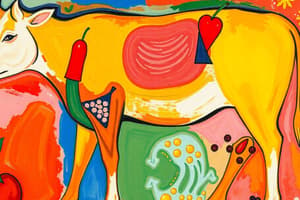Podcast
Questions and Answers
What are the three categories of animals based on their diet?
What are the three categories of animals based on their diet?
Herbivores, Carnivores, and Omnivores
What are the three main components that an animal's diet must provide?
What are the three main components that an animal's diet must provide?
Chemical energy, Organic building blocks, and Essential nutrients
How many amino acids can animals synthesize from molecules in their diet?
How many amino acids can animals synthesize from molecules in their diet?
About half of the 20 amino acids
What type of proteins are meat, eggs, and cheese?
What type of proteins are meat, eggs, and cheese?
Why is it necessary for individuals who eat only plant proteins to eat specific plant combinations?
Why is it necessary for individuals who eat only plant proteins to eat specific plant combinations?
What are the two fatty acids known to be essential for humans?
What are the two fatty acids known to be essential for humans?
What is the characteristic of essential fatty acids?
What is the characteristic of essential fatty acids?
What are the four classes of essential nutrients that must be obtained from the diet?
What are the four classes of essential nutrients that must be obtained from the diet?
What are the two categories of vitamins?
What are the two categories of vitamins?
What is the purpose of the Recommended Dietary Allowance (RDA)?
What is the purpose of the Recommended Dietary Allowance (RDA)?
What is malnourishment?
What is malnourishment?
What happens to an undernourished individual?
What happens to an undernourished individual?
What is the Global Hunger Index (GHI) used for?
What is the Global Hunger Index (GHI) used for?
How often is the Recommended Dietary Allowance (RDA) updated?
How often is the Recommended Dietary Allowance (RDA) updated?
What is the result of a diet that lacks essential nutrients?
What is the result of a diet that lacks essential nutrients?
Why are minerals required in small amounts?
Why are minerals required in small amounts?
Flashcards are hidden until you start studying
Study Notes
Human Nutrition
- Food is taken in, taken apart, and taken up in the process of animal nutrition, which involves three categories: herbivores, carnivores, and omnivores.
- An animal's diet must provide chemical energy, organic building blocks, and essential nutrients.
- There are four classes of essential nutrients that must be obtained from the diet: essential amino acids, essential fatty acids, vitamins, and minerals.
Essential Amino Acids
- Animals require 20 amino acids, and can synthesize about half from molecules in their diet.
- The remaining amino acids, essential amino acids, must be obtained from food.
- Meat, eggs, and cheese are complete proteins, providing all essential amino acids.
- Most plant proteins are incomplete in amino acid composition, requiring specific combinations to get all essential amino acids.
Essential Fatty Acids
- Animals can synthesize most of the fatty acids they need, but essential fatty acids must be obtained from the diet.
- Two fatty acids are essential for humans: linolenic acid (an omega-3 fatty acid) and linoleic acid (an omega-6 fatty acid).
- Deficiencies in fatty acids are rare.
Vitamins
- Vitamins are organic molecules required in the diet in small amounts.
- Thirteen vitamins are essential for humans, grouped into two categories: fat-soluble and water-soluble.
Minerals
- Minerals are simple inorganic nutrients, usually required in small amounts.
- Ingesting large amounts of some minerals can upset homeostatic balance.
Recommended Dietary Allowance (RDA)
- RDA is the estimated amount of a nutrient (or calories) per day considered necessary for the maintenance of good health.
- The RDA is updated periodically to reflect new knowledge.
- RDA for different nutrients varies for infants, children, pregnant and lactating women, and adults.
Dietary Deficiencies
- Malnourishment is the long-term absence from the diet of one or more essential nutrients.
- Deficiencies in essential nutrients can cause deformities, disease, and death.
- Undernutrition results when a diet does not provide enough chemical energy, leading to stored fat and carbohydrate depletion, protein breakdown, and irreversible damage.
Studying That Suits You
Use AI to generate personalized quizzes and flashcards to suit your learning preferences.




